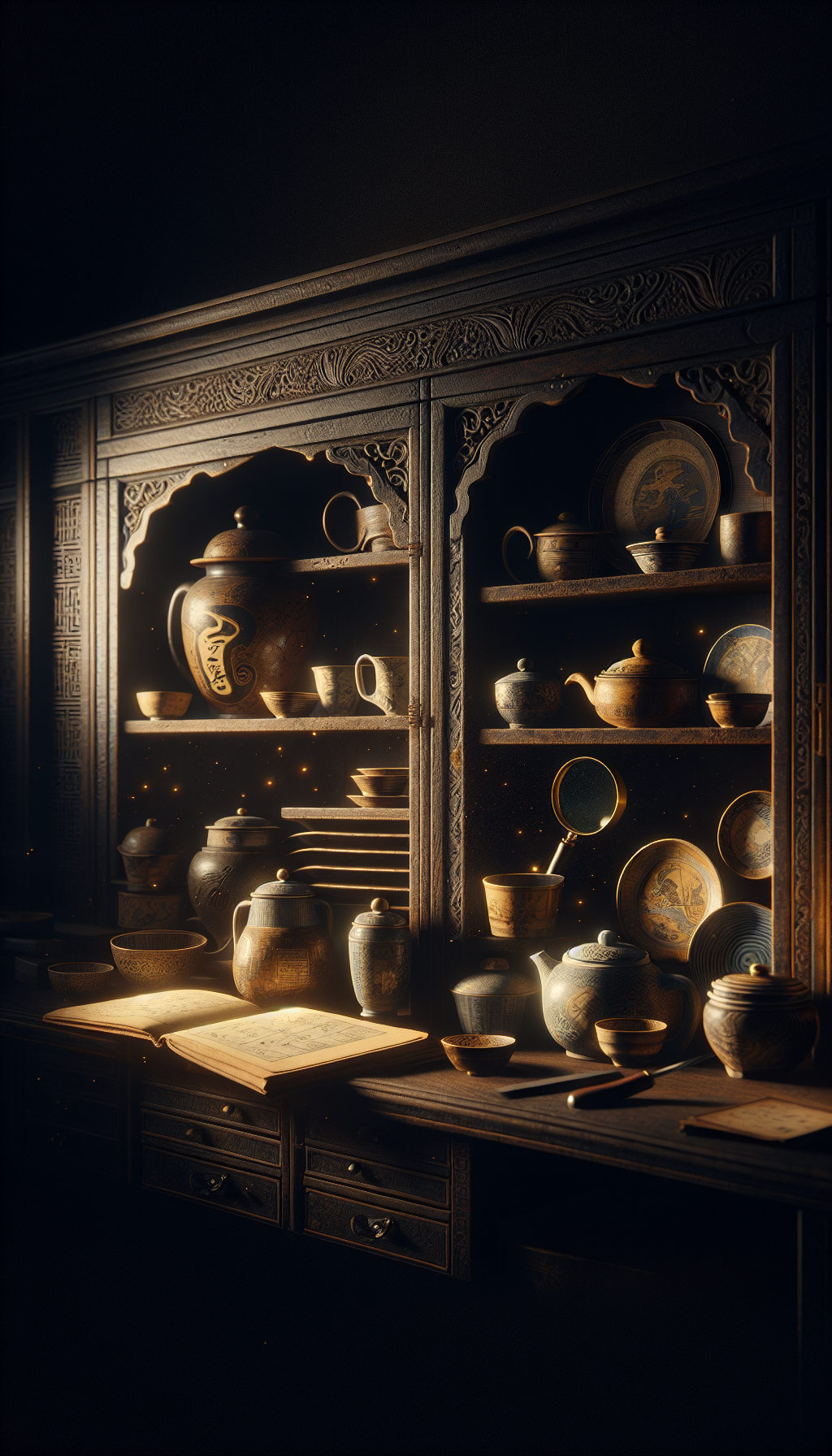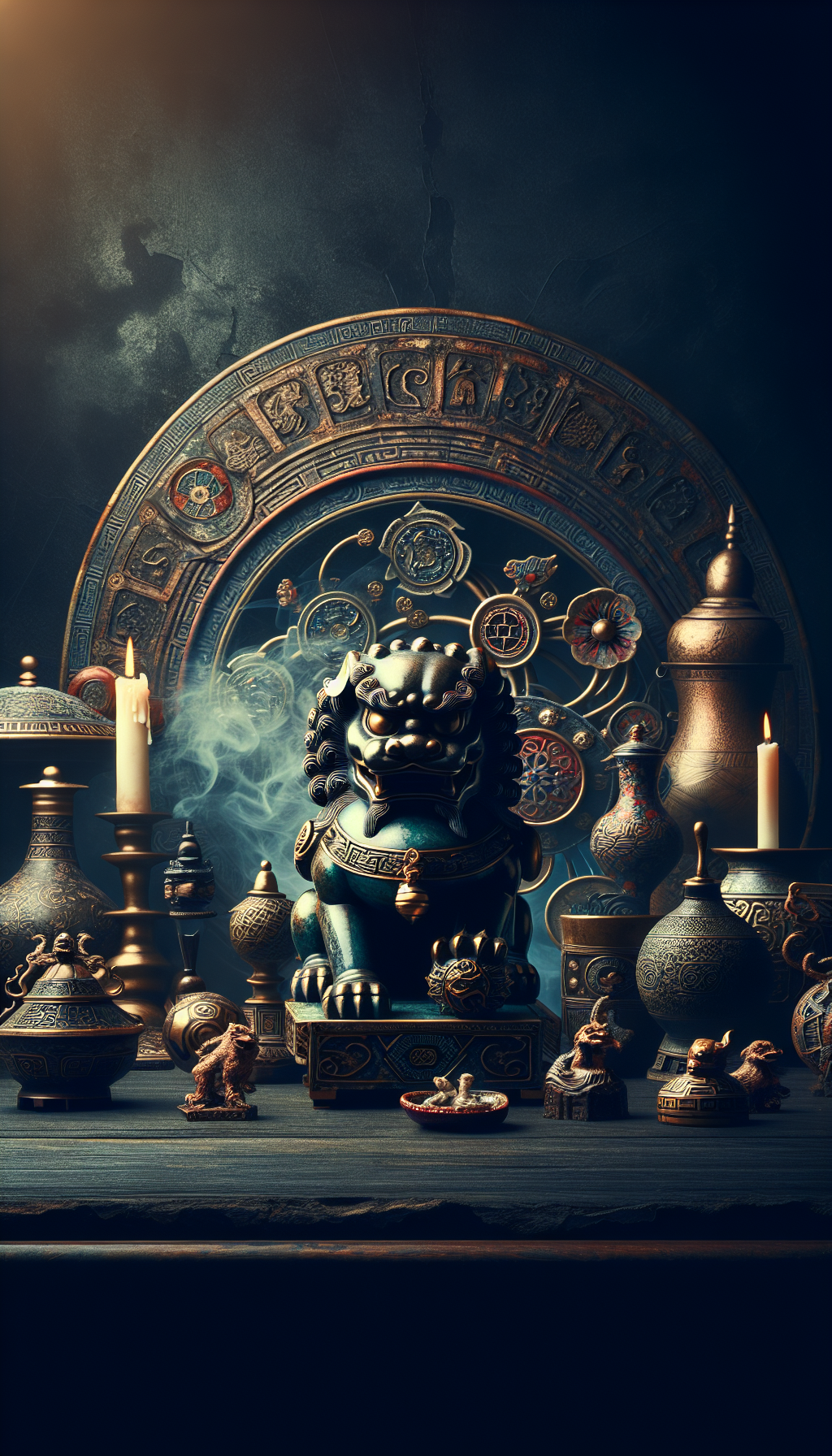A Circa 19thc Japanese Four Panel Silk Screen Edo Period Kano School
If you’re looking at a four-panel Japanese folding screen painted on silk and attributed to the Kanō school, you’re standing at the crossroads of workshop tradition, courtly taste, and the late Edo market. This guide explains what such a screen is, how to evaluate materials and technique, how to date and authenticate it within the Kanō lineage, what condition issues matter, and how these factors drive value.
What You’re Looking At: Format, Function, and Context
- Object type: Folding screen (byōbu), most likely a four-panel (often called yon-kyoku byōbu, “four-fold screen”). Four-panel screens tend to be single, not sold as pairs, and were used to partition smaller spaces, display seasonal themes, or sit behind an arrangement in a tokonoma or reception area.
- Period: Late Edo (circa 1800–1868). Many examples continued into early Meiji, and late-Edo workshops often supplied both samurai households and a growing urban merchant clientele.
- School: Kanō school (Kanō-ha). The Kanō were hereditary official painters to the shogunate and daimyo, known for disciplined brushwork, Chinese-inspired themes, and controlled use of gold grounds. Late Edo Kanō screens often balance earlier monochrome ink traditions with richer polychrome mineral pigments.
Standard dimensions for a full-size four-panel byōbu are roughly 150–170 cm (59–67 in) in height, with individual panels about 45–60 cm (18–24 in) wide, though mid-size and small formats exist. Measure the height and each panel width; uniformity and proportion inform whether the piece is intact or trimmed.
Kanō School Hallmarks: Motifs, Composition, and Workshop Practice
The Kanō school is best identified through a combination of motifs, brush language, and compositional logic:
- Motifs:
- Birds-and-flowers (kachōga): cranes and pines (sho-chiku-kaku), pheasants among peonies, quail in autumn grasses, or Mandarin ducks on a stream—iconography laden with auspicious meaning.
- Tigers and bamboo or hawks on perches: subjects favored by warrior patrons, rendered with muscular ink outlines and selective color.
- Landscapes in Chinese idiom: pine-clad mountains, pavilions in mist, scholar’s retreats; late Edo versions often mix ink with restrained color highlights.
- Composition:
- A clear “read” across the fold sequence, usually right to left, with a primary subject anchoring an end panel and diagonals leading the eye across joins.
- Controlled negative space, especially on gold or misted grounds, used to set off strong silhouettes (pines, cranes, rock forms).
- Brushwork:
- Decisive bone lines (kotsu-sen) in tree trunks and rocks; textured ink modeling (hatsuboku in earlier works, tighter texturing in later Edo).
- In polychrome works, mineral pigments (iwa-enogu) layered over sizing, with gofun (calcium white) sparingly highlighting feathers, waves, or mist.
Late Edo Kanō painting was collaborative. Assistants often executed grounds, foliage, and secondary creatures; a senior hand added faces, beaks, or key contour accents, then signed and sealed, typically on the final panel lower corner. Attributions to a specific Kanō master (e.g., Kanō Osanobu/Seisen’in) must be evaluated against workshop hands and the prevalence of copied signatures.
Materials and Construction: Silk, Gold, and How the Screen Is Built
Understanding the build of a byōbu is essential to both authentication and appraisal.
- Ground:
- Silk (kinu-ji): Fine silk shows a subtle diagonal weave or grid under raking light. It takes mineral pigments vividly and was a premium choice; late Edo screens in silk are not uncommon for high-end commissions.
- Paper (shihon): More matte, with visible fibers; more commonly used across periods. If your screen is silk, confirm by visual weave and feel—do not touch bare paint; use magnification.
- Pigments and binders:
- Mineral pigments (azurite, malachite, cinnabar, orpiment), gofun white, and animal glue (nikawa). Gold leaf (kinpaku) may appear as full fields, clouds, or cut-leaf accents (kirigane); mica (kirazuri) can add sparkle.
- Ink (sumi) for linework and shading; late Edo often shows precise ink structure under color glazes.
- Structure:
- Each panel: light wooden lattice core (kōshi) faced with multiple washi layers; the painted silk or paper is laid over a prepared surface.
- Hinges: Paper hinge system—edges of adjacent panels overlapped with strong paper; there is no metal hinge. The screen folds both ways with alternating hinge direction.
- Frame: Thin wood frame (fuchi) often lacquered black or brown; end panels may have corner fittings (kanagu). Backing paper (ura-gami) sometimes stenciled (karakami) with repeating patterns.
Clues in construction help date:
- Nails: Bamboo/wooden pegs and square hand-forged nails indicate earlier mounting; modern wire nails suggest late 19th century or later re-framing.
- Back papers: Hand-stenciled karakami and high-quality washi point to Edo; machine-made, smooth, bright white papers are more likely Meiji/Taishō restorations.
- Gold ground: Thick, slightly irregular leaf join lines and warm, soft sheen are more typical of older gold; very bright mirror-like surfaces can indicate later leaf or re-gilding.
Dating and Authentication: Late Edo vs. Meiji and Sorting Signatures
When assessing a “circa 19thc Edo period Kanō school” screen, weigh evidence across several axes:
- Signature and seals:
- Placement: Usually lower right or left of the final panel in the reading flow. Some Kanō signatures are followed by a stylized kao (cursive cipher).
- Script: Look for confident, elastic brush in the signature; tremor or hesitant strokes can flag later additions.
- Seals (in red cinnabar): Compare carving quality and paste tone; blurred, overly large, or generic “Kanō” chops suggest workshop or later enhancement rather than a named master.
- Subject and handling:
- Classic Kanō themes rendered with disciplined contouring and keyed color are more likely; exuberant, export-oriented florals with heavy tarashikomi effects lean Rinpa/Meiji.
- Late Edo tends to avoid overly sentimental animal faces or sugary color; Meiji export pieces often brighten palettes and simplify drawing for Western tastes.
- Mounting history:
- Look for remount tags or kiwamefuda (old attribution labels) on the reverse, dealer or temple inventory numbers, or Japanese paper notes tucked inside the frame. These help place the screen in Japan before export.
- Wear patterns:
- Consistent age throughout (surface craquelure in pigments, slight silk discoloration, minor lifting at panel joins) is a positive sign. A pristine painting on a heavily aged frame, or vice versa, can indicate component replacement.
Always correlate: a late Edo screen may have been remounted in Meiji or later. That does not negate period painting, but it affects value and conservation decisions.
Condition and Conservation: What Matters Most
The condition of a silk-ground screen is pivotal. Common issues and their impact:
- Pigment loss and flaking:
- Mineral pigment layers are brittle; cupping or loss along folds and edges is typical. Localized, stable flaking is acceptable; active loss requires immediate conservation by a trained hyōgu-shi (mounter).
- Silk degradation:
- Silk can become brittle, showing transverse cracks that telegraph through paint. Honeycombing or “shattering” reduces structural integrity and complicates treatment.
- Water staining and tide lines:
- Visible on gold and pale areas; can be reduced, but not easily reversed. Large stains lower value.
- Mold and foxing:
- Black speckling or musty odor indicates improper storage; remediation is specialized and costly.
- Insect damage:
- Pinholes and tunneling in the back papers or frame from wood-borers; check for frass and treat before bringing indoors.
Display and care tips:
- Light: Keep below roughly 50 lux; avoid direct sun and high UV. Prolonged exposure desaturates pigments and embrittles silk.
- Climate: Aim for 45–55% relative humidity and stable temperature. Rapid swings stress hinges and paint.
- Positioning: Place on a clean, dry floor or low platform; prevent sagging. Do not force folds beyond the natural hinge direction.
- Cleaning: Dust gently with a soft brush; never wipe painted surfaces. Leave any structural or surface treatment to a professional.
Conservation treatments—like full remounting (harikae) with new back papers—are often essential for long-term stability. Budget realistically; a competent remount can range widely depending on region and complexity and may approach or exceed mid-market value for workshop pieces.
Market and Valuation: What Drives Price
Value in four-panel Kanō school screens derives from quality, condition, subject, and attribution:
- Quality of hand:
- Strong, assured drawing, layered mineral color, and dynamic composition command a premium. Workshop “school” pieces with competent but formulaic execution sit lower.
- Subject hierarchy:
- Powerful warrior-associated themes (hawk on perch, tiger and bamboo), elegant cranes and pines, or sophisticated literati landscapes typically outperform generic blossoms.
- Ground and gold:
- Silk grounds and tasteful gold clouding elevate value relative to flat paper with little embellishment, assuming good condition.
- Scale and presence:
- Full-size four-panel screens that read well at distance and have balanced negative space attract designers and collectors alike.
- Attribution and provenance:
- A credible attribution to a late Edo Kanō master with matching seals and quality can push prices significantly higher. Solid provenance (estate records, prewar photos) adds confidence.
Indicative ranges vary by region and sale channel:
- Good late Edo “Kanō school” four-panel in silk with minor condition issues: often mid–to–high four figures.
- Strong, named-artist attributions with quality and condition: potentially low–to–mid five figures.
- Decorative but tired examples with heavy condition problems or weak hands: lower four figures or less.
Remember: a professional appraisal should examine the piece in person. Photos rarely capture pigment surface, silk weave, or hinge integrity adequately.
Quick Appraisal Checklist
- Confirm the ground:
- Under magnification, can you see a silk weave? Is the surface slightly lustrous compared to matte paper?
- Read the composition:
- Does the subject “flow” coherently across panels with good spacing and clear focal points?
- Examine brushwork:
- Are lines decisive and modulated, or timid and mechanical? Are feathers/fur/rocks modeled with confidence?
- Check gold and pigments:
- Do mineral colors have fine granularity and depth? Are gold leaf join lines irregular and warm in tone?
- Inspect signature and seals:
- Placement at the terminal panel? Is the seal crisp and in proportion? Does the calligraphy match late Edo Kanō conventions?
- Look behind:
- Back papers hand-stenciled or machine? Any old labels, inventory marks, or remount notes?
- Assess condition:
- Note flaking, silk cracks, water stains, mold, and hinge strength. Photograph issues panel by panel.
- Consider mounting integrity:
- Frames intact, corners tight, no wire nails intruding into the panel face.
- Record measurements and weight:
- Height, each panel width, overall span; this helps compare to standard formats.
- Pause before cleaning:
- Do not attempt surface cleaning or repairs without a specialist; you can lower value inadvertently.
Frequently Asked Questions
Q: How can I tell if the gold is real gold leaf or paint? A: Under raking light, true leaf shows subtle seams (squares or rectangles) and a soft, warm reflectivity. Metallic paint appears uniform with no leaf join lines and often a cooler or brassy tone. A conservator can confirm non-invasively.
Q: My screen is signed “Kanō …” — does that guarantee a master’s work? A: Not necessarily. Late Edo Kanō workshops allowed assistants to execute much of a painting, with a senior hand adding finishing touches and a signature. Assess whether brush quality and seals align with the purported master; workshop pieces are often labeled “Kanō school.”
Q: Is silk better than paper for value? A: Silk was a premium ground and can add value when the painting quality is high. However, silk ages more vulnerably than paper. A superb paper-ground screen in fine condition can outvalue a damaged silk example.
Q: Can I display the screen near a window with UV-filtering film? A: Even with UV control, avoid direct sunlight and high ambient light. Keep exposure low, rotate displays, and maintain stable humidity to protect pigments and silk.
Q: What does conservation typically involve and how long does it take? A: A professional hyōgu-shi may consolidate flaking pigments, remove and replace failing back papers, repair hinges, and adjust frames. Timelines range from weeks to several months depending on condition and workshop schedules.
By focusing on materials, brushwork, mounting, and condition—and by situating the piece within late Edo Kanō practice—you can make a disciplined, defensible assessment of a 19th-century four-panel silk byōbu. For any doubts, seek an in-person evaluation; subtlety is the hallmark of both the Kanō school and successful connoisseurship.




